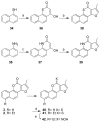Antitumor agents. 272. Structure-activity relationships and in vivo selective anti-breast cancer activity of novel neo-tanshinlactone analogues
- PMID: 20148565
- PMCID: PMC2849726
- DOI: 10.1021/jm1000858
Antitumor agents. 272. Structure-activity relationships and in vivo selective anti-breast cancer activity of novel neo-tanshinlactone analogues
Abstract
Neo-tanshinlactone (1) and its previously reported analogues, such as 2, are potent and selective in vitro antibreast cancer agents. The synthetic pathway to 2 was optimized from seven to five steps, with a better overall yield. Structure-activity relationships studies on these compounds revealed some key molecular determinants for this family of antibreast agents. Several derivatives (19-21 and 24) exerted potent and selective antibreast cancer activity with IC(50) values of 0.3, 0.2, 0.1, and 0.1 microg/mL, respectively, against the ZR-75-1 cell lines. Compound 24 was 2- to 3-fold more potent than 1 against SK-BR-3 and ZR-75-1. Importantly, 21 exhibited high selectivity; it was 23 times more active against ZR-75-1 than MCF-7. Compound 20 had an approximately 12-fold ratio of SK-BR-3/MCF-7 selectivity. In addition, analogue 2 showed potent activity against a ZR-75-1 xenograft model, but not PC-3 and MDA-MB-231 xenografts, as well as high selectivity against breast cancer cell line compared with normal breast tissue-derived cell lines. Further development of lead compounds 19-21 and 24 as clinical trial candidates is warranted.
Figures








Similar articles
-
Antitumor agents. 254. Synthesis and biological evaluation of novel neo-tanshinlactone analogues as potent anti-breast cancer agents.J Med Chem. 2006 Sep 7;49(18):5631-4. doi: 10.1021/jm060184d. J Med Chem. 2006. PMID: 16942038
-
Antitumor agents. 266. Design, synthesis, and biological evaluation of novel 2-(furan-2-yl)naphthalen-1-ol derivatives as potent and selective antibreast cancer agents.J Med Chem. 2009 Jun 11;52(11):3586-90. doi: 10.1021/jm9001567. J Med Chem. 2009. PMID: 19425534 Free PMC article.
-
Antitumor agents 270. Novel substituted 6-phenyl-4H-furo[3,2-c]pyran-4-one derivatives as potent and highly selective anti-breast cancer agents.Bioorg Med Chem. 2010 Jan 15;18(2):803-8. doi: 10.1016/j.bmc.2009.11.049. Epub 2009 Dec 2. Bioorg Med Chem. 2010. PMID: 20034799 Free PMC article.
-
Molecular hybridization used to design and synthesize neo-tanshinlactone derivatives as PD-1/PD-L1 inhibitors.Bioorg Med Chem. 2022 Jan 15;54:116579. doi: 10.1016/j.bmc.2021.116579. Epub 2021 Dec 16. Bioorg Med Chem. 2022. PMID: 34954618
-
In-vitro Evaluation of Isatin Derivatives as Potent Anti-Breast Cancer Agents against MCF-7, MDA MB 231, MDA-MB 435 and MDA-MB 468 Breast Cancers Cell Lines: A Review.Anticancer Agents Med Chem. 2022;22(10):1883-1896. doi: 10.2174/1871520621666210903130152. Anticancer Agents Med Chem. 2022. PMID: 34477529 Review.
Cited by
-
Tanshinones: sources, pharmacokinetics and anti-cancer activities.Int J Mol Sci. 2012 Oct 22;13(10):13621-66. doi: 10.3390/ijms131013621. Int J Mol Sci. 2012. PMID: 23202971 Free PMC article. Review.
-
Antitumor agents 279. Structure-activity relationship and in vivo studies of novel 2-(furan-2-yl)naphthalen-1-ol (FNO) analogs as potent and selective anti-breast cancer agents.Bioorg Med Chem Lett. 2011 Jan 1;21(1):52-7. doi: 10.1016/j.bmcl.2010.11.077. Epub 2010 Nov 21. Bioorg Med Chem Lett. 2011. PMID: 21147529 Free PMC article.
-
Synthesis of Chromeno[4,3-b]pyrrol-4(1H)-ones through a Multicomponent Reaction and Cyclization Strategy.ACS Omega. 2020 Aug 19;5(34):21968-21977. doi: 10.1021/acsomega.0c03589. eCollection 2020 Sep 1. ACS Omega. 2020. PMID: 32905458 Free PMC article.
-
Furo[3,2-c]coumarins carrying carbon substituents at C-2 and/or C-3. Isolation, biological activity, synthesis and reaction mechanisms.RSC Adv. 2020 Sep 10;10(55):33344-33377. doi: 10.1039/d0ra06930b. eCollection 2020 Sep 7. RSC Adv. 2020. PMID: 35515056 Free PMC article. Review.
-
Discovery and development of natural product-derived chemotherapeutic agents based on a medicinal chemistry approach.J Nat Prod. 2010 Mar 26;73(3):500-16. doi: 10.1021/np900821e. J Nat Prod. 2010. PMID: 20187635 Free PMC article. Review.
References
-
- Balunas MJ, Kinghorn AD. Drug discovery from medicinal plants. Life Sci. 2005;78:431–441. - PubMed
-
- Saklani A, Kutty SK. Plant-derived compounds in clinical trials. Drug Discov Today. 2008;13:161–171. - PubMed
-
- Rishton GM. Natural products as a robust source of new drugs and drug leads: past successes and present day issues. Am J Cardiol. 2008;101:43D–49D. - PubMed
-
- Vuorelaa P, Leinonenb M, Saikkuc P, Tammelaa P, Rauhad JP, Wennberge T, Vuorela H. Natural products in the process of finding new drug candidates. Curr Med Chem. 2004;11:1375–1389. - PubMed
-
- Tan G, Gyllenhaal C, Soejarto DD. Biodiversity as a source of anticancer drugs. Curr. Drug Targets. 2006;7:265–277. - PubMed
Publication types
MeSH terms
Substances
Grants and funding
LinkOut - more resources
Full Text Sources
Other Literature Sources
Miscellaneous

